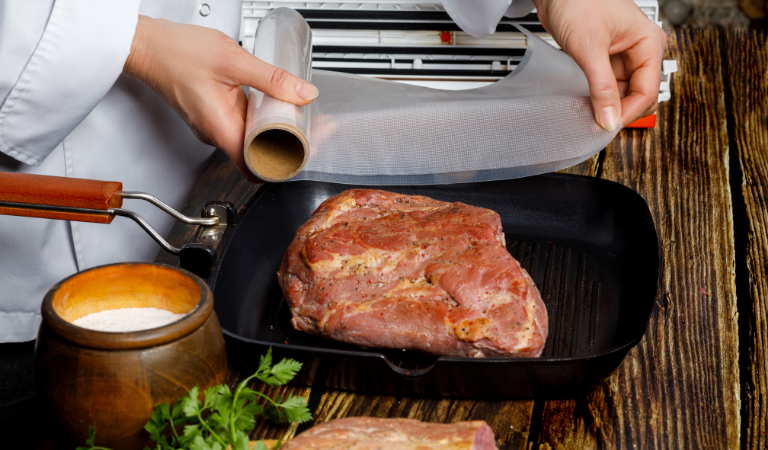Catering an off-site event without a kitchen presents caterers with one of their biggest challenges: transporting food from their kitchens to events. Caterers need to preserve the quality and temperature of high-risk foods while following basic sanitation practices. They also need to properly load meals into their catering vehicles to stay organized and prevent messy accidents. To ensure your food meets the standards of clients, we’ve created a detailed guide to inform you on how to efficiently transport food to catering events.
How To Preserve The Temperature Of Food During Transport
Maintaining the freshness of food made in your kitchen until it's served at events can be challenging. Meals likely won’t be served for at least a few hours and foods tend to lose their quality during transport. To maintain the temperature of hot and cold foods, caterers rely heavily on insulated food pan carriers. Food pan carriers allow caterers to fit various food pans and retain food temperatures for up to 7 hours. They are perfect for transporting your meals to events located in different cities and eliminate the worry of high-risk foods spoiling.
How To Preserve The Temperature Of Drinks During Transport
 Your clients may request coffee for their brunch event or juice for their wedding. Maintaining the temperature of beverages during transport can be difficult. Hot tea quickly loses its freshness and storing fresh lemonade in a conventional carafe with ice will water down the lemonade. That is why many caterers store hot and cold beverages for events in insulated beverage dispensers. Insulated drink dispensers feature superior temperature retention to maintain the temperature of hot and cold beverages for up to 7 hours. They also feature a faucet, allowing you to easily serve drinks into carafes or cups.
Your clients may request coffee for their brunch event or juice for their wedding. Maintaining the temperature of beverages during transport can be difficult. Hot tea quickly loses its freshness and storing fresh lemonade in a conventional carafe with ice will water down the lemonade. That is why many caterers store hot and cold beverages for events in insulated beverage dispensers. Insulated drink dispensers feature superior temperature retention to maintain the temperature of hot and cold beverages for up to 7 hours. They also feature a faucet, allowing you to easily serve drinks into carafes or cups.
How To Properly Package Meals For Transport
Properly packaging food for transport helps preserve the flavors and appearance of meals while preventing cross-contamination. To guarantee dishes are fresh for your off-site event, it’s important to understand how you should package meals and organize them in your catering vehicle.
Package Each Dish Separately
Packaging hot and cold foods together can pose a food safety concern. Their temperatures will be affected which compromises the quality of each dish. For instance, if clients request ceviche and chicken wings for their wedding cocktail hours, store them in separate food pans or containers to prevent cross-contamination. You should also cover menu items with lids, aluminum foil, or plastic wrap to protect them during transport.
Many caterers store hot and cold foods in separate food pan carriers when transporting multiple menu items to events. That’s because hot and cold foods need to be kept at specific temperatures to prevent them from spoiling:
- Hot foods: Most hot foods should be stored at 140 °F or higher. Hot meals that are left below 140 °F for more than four hours will likely spoil.
-
Cold foods: The majority of cold foods should be stored at 40 °F or lower. Cold foods that are left in temperatures higher than 40 °F for more than two hours will likely go bad.

Organize Food In Your Vehicle
When transporting meals in your catering van or food truck, you will likely drive over speed bumps, potholes, or make sharp turns. If you don't properly store your food and beverages in the vehicle, they are likely to be knocked over and create a mess. To keep your vehicle clean and make unloading a breeze, it’s essential to properly organize your van before heading out to an event:
- Use your shelves: Many food trucks and catering vans come with built-in shelves. Before placing products on the floor, fill your shelves first. The shelves are designed to maximize storage space and prevent items from falling out during transport.
- Load heavy items: When loading your vehicle, you want to create a stable base with your heaviest items. Store the heaviest items first and place lighter products on top. This will prevent your heavier items from crushing your lighter products.
- Organize up: To maximize your space, stack boxes on top of each other. You can keep them in place by using the walls of your vehicle, horizontal poles, or providing support with other catering equipment.
- Remove unnecessary items: If you have products in your van that you know are not needed for the event, remove them. Losing the clutter will enhance your organization and allow you to unload food and catering supplies from your vehicle with ease.
Safely Transport Drinks & Food To Your Next Catered Event
At times, you will be asked to cater events at venues without a kitchen available to you. Rather than turning down the business opportunity, use insulated beverage dispensers and food pan carriers to transport your menu items. These dispensers and carriers are specially designed to retain the temperature of your dishes, ensuring that your meals are fresh when served to guests. By following these tips on how to transport hot food and organize your vehicle for events, catering off-site events will be a breeze.








